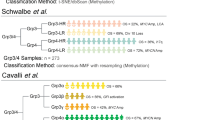Abstract
Background
Although the 5-year survival rates in pediatric acute myeloid leukemia (AML) have improved over the last decades, there is a high relapse rate for Pediatric AML patients.
Methods
In the present study, we mainly combine PCA with the LASSO technique to identify prognostic markers for Pediatric AML patients coming from the NCI TARGET database.
Results
Three key genes (EEF1A1, RPLP2, RPL19) associated with poor prognosis of pediatric AML has been screened by both PCA and LASSO Cox regression analysis. Simultaneously, we developed a risk score model to predict the prognosis of pediatric AML, according to risk scores, the patients were divided into high‐ and low‐risk groups based on the median risk score. Kaplan–Meier survival analysis indicated that Pediatric AML patients with the high-risk group have a poorer survival rate than those with a low‐risk group (p < 0.000). The receiver operating characteristic (ROC) analysis showed that the risk model has a good performance (AUC:0.669). Moreover, the clinicopathologic correlation showed that the expression levels of three genes were related to the central nervous system (CNS) disease and chloroma. GSEA identified that those pathways including oxidative phosphorylation, apoptosis and TGFB signaling pathway were differentially enriched.
Conclusion
Taken together, those studies suggested that a gene panel that consists of three genes (EEF1A1, RPLP2, RPL19) may act as a potential prognostic marker.





Similar content being viewed by others
Data availability
Data collections and processions were performed according to policies of TARGET project.
References
Sexauer AN, Tasian SK. Targeting FLT3 Signaling in Childhood acute myeloid leukemia. Front Pediatr. 2017;5:248.
Rubnitz JE. Current management of childhood acute myeloid leukemia. Paediatr Drugs. 2017;19:1–10.
Hunger SP, Mullighan CG. Acute lymphoblastic leukemia in children. N Engl J Med. 2015;373:1541–52.
Rubnitz JE. How I treat pediatric acute myeloid leukemia. Blood. 2012;119:5980–8.
Vardiman JW, et al. The 2008 revision of the World Health Organization (WHO) classification of myeloid neoplasms and acute leukemia: rationale and important changes. Blood. 2009;114:937–51.
Meldrum C, Doyle MA, Tothill RW. Next-generation sequencing for cancer diagnostics: a practical perspective. Clin Biochem Rev. 2011;32:177.
Zuo S, et al. A robust six-gene prognostic signature for prediction of both disease-free and overall survival in non-small cell lung cancer. J Transl Med. 2019;17:152.
Adamson PC. Improving the outcome for children with cancer: development of targeted new agents. Cancer J Clin. 2015;65:212–20.
Downing JR, et al. The pediatric cancer genome project. Nat Genet. 2012;44:619.
Carlson M. org.Hs.eg.db: Genome wide annotation for human. R package version 3.8.2. R Development Core Team: Vienna, Austria. 2019.
Todorov H, Fournier D, Gerber S. Principal components analysis: theory and application to gene expression data analysis. Genom Comput Biol. 2018;4:e100041.
Wei T, et al. Package ‘corrplot’. Statistician. 2017;56:316–24.
Subramanian A, et al. Gene set enrichment analysis: a knowledge-based approach for interpreting genome-wide expression profiles. Proc Natl Acad Sci. 2005;102:15545–50.
Wu H, Zhang J. Decreased expression of TFAP2B in endometrial cancer predicts poor prognosis: a study based on TCGA data. Gynecol Oncol. 2018;149:592–7.
de Rooij JDE, Zwaan CM, van den Heuvel-Eibrink M. Pediatric AML: from biology to clinical management. J Clin Med. 2015;4:127–49.
Perry H, et al. Care Groups II: a summary of the child survival outcomes achieved using volunteer community health workers in resource-constrained settings. Glob Health Sci Pract. 2015;3:370–81.
Jolliffe IT. Pincipal component analysis. J Mark Res. 2002;25:513.
Penzo M, Montanaro L, Treré D, Derenzini M. The ribosome biogenesis-cancer connection. Cells. 2019;8:55.
Cox DR. Regression models and life-tables. J R Stat Soc. 1972;34:187–220.
Santosa F, Symes WW. Linear inversion of band-limited reflection seismograms. SIAM J Scie Stat Comput. 1986;7:1307–30.
Bao Y, et al. High eukaryotic translation elongation factor 1 alpha 1 expression promotes proliferation and predicts poor prognosis in clear cell renal cell carcinoma. Neoplasma. 2020;67:78–84.
Campos RK, et al. RPLP1 and RPLP2 are essential flavivirus host factors that promote early viral protein accumulation. J Virol. 2017;91:e01706–01716.
Bee A, et al. Ribosomal protein l19 is a prognostic marker for human prostate cancer. Clin Cancer Res. 2006;12:2061–5.
Hong M, Kim H, Kim I. Ribosomal protein L19 overexpression activates the unfolded protein response and sensitizes MCF7 breast cancer cells to endoplasmic reticulum stress-induced cell death. Biochem Biophys Res Commun. 2014;450:673–8.
Acknowledgements
We would like to thank TARGET databases for providing high‐quality clinical data on Pediatric AML.
Author information
Authors and Affiliations
Contributions
HW: designed this study. ZC and YW, FZ: wrote the manuscript and contributed to preparing and making figure and tables. All authors read and approved the final manuscript.
Corresponding author
Ethics declarations
Conflict of interest
The authors declare that they have no competing interests.
Ethical approval
The study was approved by the Ethics Committee of The First Affiliated Hospital of University of South China (Hengyang, Hunan Province, China).
Informed consent
Not applicable.
Additional information
Publisher's Note
Springer Nature remains neutral with regard to jurisdictional claims in published maps and institutional affiliations.
Rights and permissions
About this article
Cite this article
Cai, Z., Wu, Y., Zhang, F. et al. A three-gene signature and clinical outcome in pediatric acute myeloid leukemia. Clin Transl Oncol 23, 866–873 (2021). https://doi.org/10.1007/s12094-020-02480-x
Received:
Accepted:
Published:
Issue Date:
DOI: https://doi.org/10.1007/s12094-020-02480-x




